
Introduction
When we think to have a website for our business or brand, it’s a huge task before everyone to look into who is best Web Development is like a house building where everyone plays an important role be it a developer or a content writer. Now a day there are so many companies are developing the website Design but who is good or bad it’s a very difficult task to judge especially who is a novice in this field. Need not to worry if you are new in this field, I will help you to select the best web development company.
Here are some useful tips that can help you in your selection
1: To begin with, first, you need to look into the project they have finished until now. You can ask the details of the project they have finished. Every project has different looks, so you need to be careful whether it has done by them, or they have copy-paste from other, so for that, you can cross-verify by asking them when you built this, how many developers were there, when you finished this project, what technologies you use while developing them. If they have developed that they will answer you in an elaborating manner, else they will answer you in short.
2: Check every project by opening different tabs, menu bar, see the time it is taking to open. Basically, a slow website takes a long time to open. Some tab will not open when you try to open them. A good website takes a very small- time to open, and it will not hang when you open them.
3: Check the design of the website, a well-furnished home looks beautiful with design, same is the case with a website. A website looks good with creatives and design. The latest design speaks the latest trend of design and shows the creativity of the designer.
4: There is a Chrome extension called Wapplalyzer, you can download it on your computer or laptop. This app will help you know the technology it is built like WordPress, PHP, Python, etc. Now ask the company about the technology they have built the specific website.
5: A good agency always follows the client’s needs. Ask what you need from them, see their response whether they are giving you want you to need or not. If they are interested in your project, they will do what you demand. A slow response shows they have no interest in your project.
6: Ask them for client details that they have worked before. If they are giving you straight without any hesitation show that they have done that project, and vice versa.
7: A good agency always uplifts itself in terms of technology. Ask the latest technology they are working on and compare them with google, whether the information provided by them is right or wrong.
8: Check their social media presence like LinkedIn, Facebook, Twitter, etc. Look for the reviews giving by customers on their pages but also be aware because most of those fake companies are giving positive feedback to their own agency by making a fake profile so that no one can recognize them.
9: Do not look more into company portfolio it’s called ready-made and copy-paste technology now a day. Most of the companies are just copying others' lines and designs to make their portfolio a real look which in general it is virtual and fake. So beware of that.
10: Pricing of the project. You can ask the various vendor about the price. The different vendors will give you a different price, someone will give you high some will give you low, many of them will give you a lower rate that means they will compromise with your project.
There is a proverb “The cheap buyer takes the bad meat” which is proved in day to day life, so please, don’t find a cheap option for your project. Now a day the most business is global, so if you really want to grow your customers and client base go for Quality web development services. It will cost you one time but its return will be forever. Don’t downplay the importance of your website and your business. You will find many companies willing to negotiate within your budget.
At last, a web development company should be like an experienced mason who can create a wonderful website which you are looking for and that can do some modification if needed.

It is so clear that social and economic anxieties are running high within our world. The reasons are obviously diverse and complex. However, one root theme that encompasses the socio-economic anxiety is economic and technological disruption and its impact throughout all corners of the world economy.
If we examine industries that sparked and fire-powered the U.S. economy in the ‘80s (the automotive industry), ‘90s and ‘00s (technology/Silicon Valley), at the root of these economic evolutions and revolutions were STEM (Science, Technology, Engineering and Mathematics) based concepts and
How will technical disruptions and automation affect the future of work and labor?
Will there be enough jobs to go around as automation becomes more prevalent in our work places and offices?
Will new jobs created by technology and automation offset the loss of traditional administrative and manufacturing jobs?
What will become of displaced workers?
And perhaps the most important question: will our children experience the same level of prosperity and quality of life as previous generations?

Economic Inequality, Rising Automation and the Long-Term Ramifications
After nine years of sustained economic growth and with unemployment hovering around 4%, polling shows that most Americans feel we are still on the wrong track. Considering the success of populist-centric campaigns on the left and right during the most recent election cycle, it is clear that the economic anxieties are the vitality of America’s political unrest.
For generations, the American Dream is the most defining feature. The belief is that if you were willing to work hard enough, you could improve not only your economic prospects, but also the future prospects of your children. However, it’s safe to say that the economic strides since the Great Recession have not been felt by a large portion of Americans from those living in old factory towns and rural counties to those in disadvantaged urban areas.
According to a report published last year by the Federal Reserve, the richest 1% of families controlled a record-high 38.6% of the nation’s wealth in 2016. Factoring in that U.S. wage growth remains slow, with median real wages growing only 0.2% over the past year. Since 2000, it’s clear that economic inequality is growing while the economic mobility has significantly eroded over time. It has become more obvious that automation is more prevalent and it cannibalizes old manufacturing, service and clerical jobs.
According to statistics compiled by the McKinsey Global Institute last year, 39 to 73 million jobs stand to be automated in the U.S. by the year 2030 and an estimated 75 to 375 million people around the world may need to switch occupational categories or learn new skills. Technology and the disruption associated with it will inspire and force massive changes. With the study finding that automation and robotics will have an enormous impact on American society and the world. While the study finds the potential for economic inequality (and political instability) to grow, it also has a more positive outlook for the future, finding that economic growth and rising productivity could offset job losses and that technology could ultimately create higher-paying jobs in the long-run.
Embracing the Future: Policy Reforms and Technological Promise
The key to creating a more competitive and inclusive economy is not running from the disruptive effects of technology, but rather embracing it. The adoption of new technologies always happens at an accelerated rate. If we continue to cling to traditional notions and descriptions of jobs, other countries will invest in these new professions and develop entire systems by adopting next generation of technological labor.
It took the airlines 68 years and automobiles 62 years to gain 50 million users,
but it took Facebook and Twitter just two years to do the same.
The new generation of economy by emerging tech is aimed to create high-paying jobs, to promote long-term prosperity, and to bring upward economic mobility back to the U.S. However, this can only occur if we pursue reforms that embrace technology and give people the technical skills needed to fill the growing number of STEM vacancies.
In summary, by embracing the STEM, the public and private sector policy reforms is the only path forward to creating a competitive economy that works for the vast majority of Americans. Here are a handful of simple policy prescriptions that can accelerate this process
1. Placing a Higher Emphasis on STEM Education
The trendy saying “all companies are technology companies” fast becomes a practical reality. With technology becoming more ingrained in our factories and workspaces, it will be hard to find jobs in the future that don’t require a certain amount of technical prowess and familiarity. From manufacturing and transportation to healthcare and financial services, technology is not only taking and creating jobs, but also changing the nature of work, how we work and the tools we use to work throughout many diverse industries.
It has been estimated that more than two-thirds of tech jobs are already outside of the tech sector which is highlighting the important growth of technology throughout numerous sectors of the economy. Consequently, developing a strong STEM skillset is the greatest competitive approach that a professional can achieve in current job market. Also, reforming our education system to encourage the next generation to develop these skills will promote a more dynamic economy.

2. Highlighting the Diversity of Opportunity in STEM Careers
There are a number of systemic reasons for this, ranging from how we teach STEM subjects, to differing educational opportunities for those of different socio-economic backgrounds, to perhaps a lack of awareness on the diversity of opportunities that exist within STEM careers. No matter the reasons, informing students on the diversity of career paths that exist in STEM will certainly help to spark interest in filling technical vacancies throughout our economy.
For instance, it might surprise many students to know that half of all STEM jobs are in manufacturing, healthcare and construction. The Brookings Institution also notes that half of all STEM jobs are available to workers without a four-year college degree and that those jobs pay an average annual salary of $53,000—a wage that is 10% higher than jobs with similar education requirements. For those looking for an alternative to an undergraduate education (and many times at a fraction of the cost or debt), a career in STEM could prove to be a wise investment.
3. Public and Private Sector Investment in Retraining Programs
When we talk about education, we often only refer to primary and secondary schools. However, the stark reality is that education is a lifelong exercise. And those educational fields should require the next generations to keep up with the latest trends to be effective professionals. As technology advances, not only will certain jobs be displaced by new professions, the requirements and skills required for those jobs will also inevitably change.
To ensure that our professionals stay engaged in the economy, it’s crucial that the public and private sectors work together to invest in training and retraining our professionals. A strong public and private partnership will be necessary to have our economy moved forward. If we give private companies do the work and they know exact skills of their employees needed to be successful, our government will need to take a more active approach to ensure our economy remains fair and competitive. Eventually, investing in the future of our workers will go a long way toward achieving that goal.
Changing and disrupting always create a certain amount of stress and unrest. However, we can remain optimistic that this is healthy and will provide the spark necessary to fan the flames of our future. Implementing the education and policy shifts suggested above will be an enormous challenge with no doubt. At the end, embracing disruption and the emerging tech economy will strengthen the American Dream and create another generation of prosperity for all everyone in this cyber world.

If you've got a lousy manager right now, I have a sympathy for you. It can really convey the enjoyment from what it might be in a rewarding role in the future, which you might not think of. Leave your feeling undervalued, and consider whether you should begin looking for something new. However, before planning an exit strategy, you should be wise to rethink how you can better manage the manager you already have.
Having worked with many not-so-inspiring managers within my employment, I’ve learned that they provide invaluable opportunities for developing executive leadership skills and learning “what not to do” when managing people working for you. You just have to be proactive in looking for them and ready to practice some real self-leadership.
New research has found that being overworked is not the reason people leave their jobs. "We may have a tendency to associate depression and stress with work pressure and workload; however, our study shows that the workload actually has no effect on workplace depression,” Matias Brødsgaard Grynderup, Psychologist Researcher behind the study said. “People don't leave jobs, they leave managers.”
You can always learn to manage him or her. The secret is to "manage up" without him/her even realizing you are doing it. So rather than think of your manager as your manager, think of him/her as a difficult client. You should figure out how to work with if you want to get ahead, even if you’d rather not. Hopefully, the strategies below will help you on your way. Underpinning each of them is a commitment to take responsibility for your own success, regardless of the different (and difficult) personalities you will inevitably have to encounter throughout your working life.

1. Know his/her “Why” to identify prime motivations.
The better you understand what your manager does and more importantly “why”, the better positioned you are to deliver results, to manage expectations, and to avoid loss. Try to put yourself in his/her shoes and see the world and the workplace where they might do.
What does he care about?
What keeps him/her up at night?
What would he/she love more and what would he/she love less on a daily basis?
What frightens him/her?
Which important level does he/she place on impressing others?
How does he/she measure success and what does he/she think about failure?
When you know what drives your manager (even if your manager might not be fully aware of it), you can figure out his/her thoughts, which can be lined up with core values, concerns, and priorities.
2. Support success, work around weakness.
While it might sound against intuitive to support a bad manager to become more successful, there is absolutely nothing to gain by making him look worse, going to war, or facilitating his/her failure. If he is as bad as you think, he will likely do a pretty good job of that all by himself. Your misery and your bad reputation at work can be a compound result from this action.
One way is to help your manager focus on his natural strengths. Another is to proactively work around his weaknesses. If you know you have a manager who’s disorganized, then help him to be on top of things rather than whining about his lack of organizational skills. If you know your manager is often late to meetings, offer to kick off the next meeting for him. If he tends to change his mind frequently, or he is absolutely forgetful or often contradicts himself, be sure to document interactions so you can refer back to them. If you know your manager is slow to respond, continue to work on a project while you wait to hear back from him. If your manager is a shouter, don't react by shouting back. If they are petty or close-minded, don't descend to smallness yourself, rather maintain clam in professional demeanor to deal with your difficult manager.
Gandhi wrote, "Be the change you want to see in the world." In this case, act like the leader you wish your manager should be. Making yourself indispensable. Sometimes your manager can rely on you and to get help from you. It is a valuable asset when you start to look to “what's next?” By doing what you can to help your manager succeed, you lay a milky way for greater success yourself. It might not be an immediate reward. But in the long run, you can never lose by helping others do better than they otherwise would.
3. Make Your “Personal Character”.
Never let your manager’s bad behavior be an excuse for your own. It is very often that people start feeling to slack off, take longer lunches, lose interest, or stop performing well because of their bad manager. Don’t go with the flow. Keep in mind in focus on top performance. That can draw back bad tendency in the work environment. Other people do it. It does not mean you have to do it too. Stay engaged. Complain to your spouse or your friends all you want. Actually, handling a difficult manager well can really set you apart. Keep in mind that who can open or close future opportunities for you is this person.
If you feel you’ve run out of options to dealing with him reasonably, then don’t go rumor-mongering or bad-mouthing him to everyone within earshot. That will ultimately say more about you than it does about your manager. You had better following proper procedures with Human Resources or with higher-level management.
4. Give your manager a chance to respond.
Sometimes you might have some concerns and issues that you should discuss with your coworkers or manager. You may think whether you should suffer quietly or complain out loud to colleagues. Instead, you skip all by jumping to the conclusion of taking an exit from the company. That can make you miss possible and positive solutions for yourself at the end. Speak out and give him a chance to respond.
When you approach them with respect and with genuine desire to make things work better, you can open the door to whole new levels of trust, collaboration, and outcome. The door, that could remain permanently closed, would open for you otherwise.
5. Know his preferences and adapt to them.
Observe your manager’s behavioral style and preferences.
Is he fast-paced and quick to make decisions?
Is he slow to think about things or needs time to process information?
How does he like to communicate; via e-mail, in person drop-ins, by phone calls, or short memos?
The more you can tune in your style to your manager’s style when collaborating, the more he will really hear what you’re saying.
You should do personality assessments of your manager as well. It can help you adapt your style and spare a lot of strain. Working with his preferences is an obvious way of managing your manager without his ever knowing it. It’s a key leadership skill for you to develop regardless of the kind of manager you are working for. Be on top and ahead of your manager’s game!

6. Don’t be intimidated by a bully. Stand tall, never be coward.
If your manager is a yeller, a criticizer, or a judge, stand firm. If you think you have done the best you can perform, keep your head up high and don’t give him the satisfaction of pushing you down. Instead of being a coward and responding with anger, you had better asking questions, seeking to understand, and working to defuse difficult situations. It takes practice, but over time you will get better at it and he will look elsewhere for his powerful kick.
If you feel compelled to speak out to him on his behavior, go ahead and do so with a cool head and prepare in advance for the consequent fallout. It could get ugly so think throughout beforehand. What are your options? Who are your allies? Have you documented his behavior? Can you deal with the possibility of the worst outcome? Sure, it’s important to stand strong, but be smart about it. Before climbing out, be sure you've managed all risks and set up a safety net if you fall.
7. Be proactive: Do your research before jumping ship.
To manage a bad manager is not to have one at all at the beginning of your employment. Whenever you are looking to move into a new role in the same company or move to another organization, spend some time to get a sense of the culture, the leadership and the sort of management practices. If you are moving internally, make sure you do your networking ahead of time to get a sense of both the environment within the team you might be moving to. Are they leaders, who create an environment where people are inspired and supported to work hard, or are they slacked or fear about opportunities to grow? Have a coffee with whomever you know at the new company to get a sense of culture, employee engagement, morale, and management style. Investing a few hours up front could spare you a few years of frustration and strain down the line. It won’t make you feel like jumping from frying pan to fire.

As a small business owner, you have a lot of responsibilities. That’s why it’s so important to pay yourself appropriately for all the hard and incredible works you have done.
There are different tax implications for different ways you can pay yourself? Let’s take a closer look at salaries, dividends, loans, and the owner’s draws to see what your options are when it is time to run payroll for yourself.
However, the most important thing before thinking about your earning is that your business entity matters.
You can structure your business as a Sole Proprietorship, Partnership, Cooperative, LLC, S Corporation, or C Corporation.
How each entity works:
Sole proprietorship
The sole proprietorship is the most basic type of business entity. All the assets and liabilities belong to the business owner. Because of this, the business is not taxed separately. Instead, the business’s income is the owner income, and the owner usually reports it with a Schedule C and the standard Form 1040. Also, the owner will need to make estimated tax payments quarterly if the owner expects to make a profit.
Partnership
If the owner is in a business with one or more partners, it could consider a partnership. A partnership does not pay income tax at the partnership level; instead, the profits pass through to the partners. A partnership files Form 1065, and Schedule K-1 for the respective partners.
Limited Liability Corporation (LLC)
A Limited Liability Corporation (LLC) is a lightweight alternative to incorporate your business. It combines the tax pass-through of a partnership and the limitations in liabilities of a corporation. An LLC may not be taxed as a business entity. Rather, the profits may be passed through to the LLC’s members and they are taxed as personal income.
Note that an LLC is a business structure that is covered by state rules. For federal tax purposes, an LLC can be treated as a corporation, partnership, or part of the LLC’s owner’s tax return. The owner should check with your state, or a tax advisor to make sure you understand how the rules apply.
Cooperative
A Cooperative is similar to an LLC in terms of that it is also a corporation and may not pay federal taxes. Rather, profits can be passed through to the cooperative’s members. A Cooperative is different from any other business entity because of its specific rules for membership and operations. Typically, a Cooperative’s members must agree on matters of its laws/rules and operations in a democratic fashion.
S Corporation (S Corp)
If the owner is looking to incorporate the business and has it taxed separately, an S Corporation can be another option for the owner (although the owner can also set it up as a pass-through entity, like a partnership). If an S Corp is taxed as its own entity, the business owner and the employees may see tax savings since they may only be taxed on their wages. An LLC has an option to file as an S Corp for tax purposes. It’s worth noting that not all states recognize the S Corp distinction from a C Corp.
C Corporation (C Corp)
The last business entity option is the C Corp. C Corps are less popular amongst small businesses because they are more complicated than the other options and typically have costly administrative fees. One of the major drawbacks of the C Corp is the “Double Taxation.” The C Corp is taxed twice–once when it makes a profit and again when it distributes dividends to its stockholders. However, for many fast-growing startups, the C Corp is popular because it can offer stock in exchange for an ownership stake.
After knowing the fact above in the different business entities, the owner can consider in different ways that the owner can pay oneself. It depends on the business entity.Many business owners choose to become W-2 employees. The W-2 is issued if the employee (aka you as the owner) earns $600 or more in wages or equivalent. The W-2 employees are subject to withhold taxes, which are taken out each pay period. The withholding tax is a pay-as-you-go tax to the IRS and it can be calculated by using allowances on the W-4 and the IRS withholding calculator.
These three factors will determine how much should be withheld from your pay.

: Marital status
The number of allowances claimed on the W-4 Compensation (Note: This may depend on the state where you are paid.)
Employees who anticipate a full refund may be exempt from withholding. This is different from employees who are exempt; for example, clergy or certain visa holders. The functionality of having your taxes withheld is one reason why some owners choose to be W-2 employees.
The inverse is also true though. Some business owners who want to pay taxes separately may opt out of W-2 wages. The IRS may check on the business owner who does not pay themselves a “reasonable compensation” to avoid paying withholding taxes.
: Dividend
The business owner can also receive dividends. The dividends are not taxed if it is a return of capital to the shareholder. Most dividends are paid out in cash, but you can also have a dividend of stock or other assets.
: Shareholder Loan
Some owners may choose to loan themselves money through their business. A shareholder loan must have a stated interest rate, a maturity date, and covenants for non-repayment. There is some risk though. If the loan is below-market, it will be treated as a gift, dividend, contribution to capital, payment of wages, or other payments. It depends on the substance of the transaction.
: Owner’s draw
Finally, a business owner can choose to do an owner’s draw. Unlike W-2 wages, a draw is not taxed at the company level. If the owner is a sole proprietor or a partner in a partnership, his/her income is a draw. However, it’s also possible to do an owner’s draw as an LLC or even an S-Corp.
There are confusion and complication issues with an owner’s draw. Since draws are not taxed, is there a draw amount that is appropriate for a business owner?
Carin Weiss-Krolikowski of Kahuna Business Group said, “I think the most important thing for any owner of a small business is to have a good bookkeeper and a trusted tax advisor. When paying oneself as a small business owner, many owners think they only have the option for owner’s draw. Of course, this is a viable option. However, if a company is formed as an S Corporation, they can pay themselves as a W-2 employee. The same fact is with an LLC if they claim to file taxes as an S Corporation. There is also the option of Guaranteed Payments (as an LLC) where an owner can pay oneself a salary (no taxes withheld) and take the expense as a line item reducing the company’s annual tax liability. Again, I would urge any business owner to always consult a tax professional.”
However, you choose to pay yourself, make sure you’re following all the laws and paying yourself a reasonable amount. Your business (and accountant) will appreciate you.

Are you changing careers? It is an absolute must that you'll need a fresh, revamped resume to pioneer your job search in a new career persuasion. Creating a new resume isn't the easiest task. You know how much of your background and experience even if it's in a completely different industry. However, you will have to try hard to make it still be relevant.
You might realize that so many skills, especially soft ones, are transferable. However, if you're shifting from a production manager role with a publishing company to the event planning role in the wedding industry. For example, your organizational skills, leadership abilities, and strong Excel and budgeting background are all going to be applicable. In your career changing resume, you have to tell the story of your transferable skills and to explain how qualifications from your previous career are still applicable and relevant.
Due to either a shift in the industry or a shift in your interests, there are lots of reasons to make a mid-career transition. Here's how to get started developing your new resume and tips on how to create a successful career transition.
Get to know your new industry. Read job descriptions and industry news to gain a sense of the skills that employers require. Print out your current resume with your job history, and write a list of all the skills you've gained and used throughout your career. Some of these may be listed on your resume directly, but others may not. Then, list the skills usually required in your new industry and look for matches.
Think creatively. Say you're moving from sales to teaching. What are the things these roles have in common? Well, both jobs require the ability to hold the attention of the participants, to give a strong presentation, and to convey potentially complex knowledge into easy to understand and remember languages. And don't forget that you can include non-professional experience on your resume as well. For instance, are you on your condominium’s board? Do you organize baking club sales for the church? Volunteer work? Even hobbies? These can be credited for evidence of your skills and experience.
Just be careful not to overstate: The amount of 300 followers on Twitter does not make you a social media expert. However, it is reasonable to say that you have social media knowledge, have built a Twitter following, and engaged with industry thought leaders.
Use your resume objective, which appears on the top of your resume, to highlight what type of job you're seeking. The objective is all about you. However, the true purpose of the objective is to sell hiring managers on your candidacy.
In your objective, connect those stepping stones for hiring managers. You can use this space to make it clear how your former career has provided you with the skills you need in your new field, and for this job particularly.
A chronological resume, which lists experience from most recent to eldest, may be the most commonly used resume format. However, that doesn't mean it's the only option to represent yourself.
A functional resume is an alternative for someone who is switching careers. It allows the person to focus squarely on your skills and experience rather than where you worked, and when. This type of resume helps highlights the most relevant parts of your work.
If you are transitioning from sales to teaching, you can follow our above example, a functional resume allows you to show off your relevant presentation skills, instead of listing out sales jobs. It wouldn't feel meaningful to a school district.
A combination resume, which mixes the functional format with the chronological one, is also a good option when you're shifting careers.

When hiring managers/recruiters scan through your resume, they might not see relevant job titles or responsibilities from their industry. Therefore, whichever resume format you choose, use the skills section to highlight that you have the soft and hard skills required for this job. here's more information to help you know what to include in your resume skills section.
Your resume does not have to exhaustively list every position you have done, a task completed, and programs used. Think of your resume as a greatest hits album, which includes only the highlights to illuminate your resume to be relevant to hiring managers in your new field. This can be particularly important if you're switching job levels, as well as shifting careers.

New career industry, new jargon! When you work in a field for a while, jargon becomes second nature. If you're in publishing and technical writing, the Chicago Manual of Style (CMS), and the Associated Press Style (AP) would be familiar in terms. If you work online, it's the Content Management System (CMS). If you are in IT, HTML/CSS and JavaScript can be mentioned. And, if you're in healthcare, it's the Centers for Medicare & Medicaid Services.
However, there are some difficulties by using those jargons. The idea is that even though jargon can help you look like an insider in your original field, it can confuse and alienate hiring managers in your new field. Therefore, you should explain job titles, programs, and job-related tasks and achievements in clear languages that anyone can understand. Try to translate those skills and responsibilities into your new field's insider-language and shorthand.
I hope all these tips can help you find your way to start pursuing new career field by your own will of change or market forces.

The unemployment rate in America has fallen to its lowest level since 2000. And while that rate of 3.9% sounds like good news for the economy, it's a bit more complicated than that. Yes, the headline sounds very nice and impressive. The Labor Department has announced the new rate, which is down in April from a level of 4.1% in March, along with modest job gains of 164,000 that mark a rebound from the previous month. But the unemployment rate with this low can actually turn out to be pros and cons.
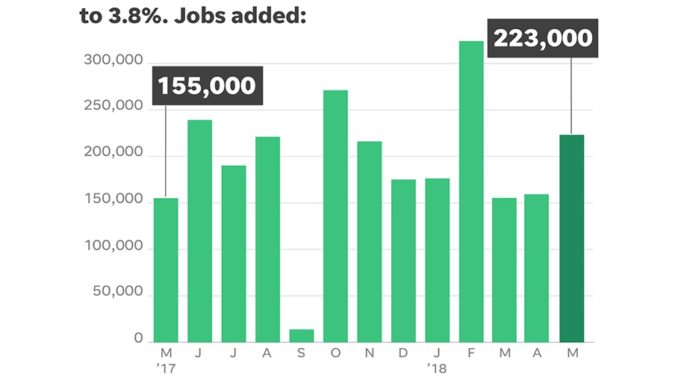
"It fell for all the right reasons. We had more people coming into the labor market. We saw employers digging deeper into the pool of unemployed," said Josh Wright, chief economist at iCIMS.
Job openings are at a record high, and businesses are desperate for workers. That has helped unrepresented Americans find jobs. Economists believe that the unemployment rate can sink more even further because there's still slack in the job market. In spite of questions about employers' ability to find qualified workers, the economy added 223,000 jobs in May. It is better than economists predicted. Job gains were broad. The retail, healthcare and construction sectors added the most positions. The economy has added 207,000 jobs a month this year on average, a faster pace than last year.
The unemployment rate among African-Americans and Asian-Americans has been steadily declining. It has also dropped among low-education workers and even teenagers. Over the past year, the unemployment rate among 16- to 19-year-olds has fallen from 14.1% to 12.8%.
The jobs report has illuminated a picture of an economy with opportunities for almost everyone. Black unemployment fell to a record low, and the gap between black and white unemployment shrank to the narrowest ever measured. "The US economy has this incredible head of steam," Wright said.
Modest wage growth remains the great puzzle in the economy. Wages are 2.7% higher than a year earlier. In 2000, the last time unemployment was this low, wages grew at a pace of about 4%. Economists are confident that wages will keep climbing as competition for workers grows. Dozens of companies have already announced pay hikes and more attractive benefits to lure workers. Costco said it would raise starting wages for US employees by $1, to a minimum of $14 an hour.
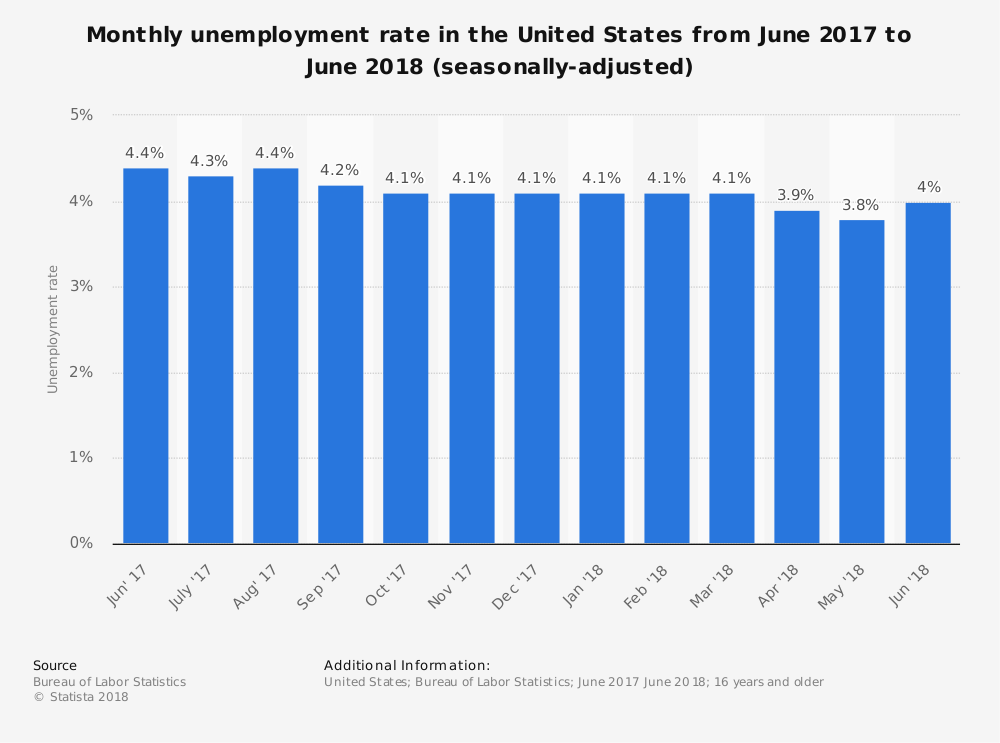
Another explanation: Employers are turning to new workers, such as younger people and those just re-entering the job market to fill positions vacated by better-paid veteran workers who are either retiring or taking new positions elsewhere.
Pros
More jobs, fewer workers. A low unemployment rate means there are fewer available workers for each job opening. That gives an advantage to job hunters and provides more opportunity to Americans on the margins of the labor force, including those less educated, disabled people and ex-offenders.
In February, there were 1.1 unemployed people for every job opening, down from a high of 6.7 in July 2009.
Higher wages and lower unemployment forces employers to raise pay more sharply to attract and retain workers. Pay has not increased as much as economists anticipated, given the sharp decline in the jobless rate. In April, for example, annual earnings gains edged down to 2.6% from 2.7%, although that’s still up from a 2.5% average the past couple of years. But with unemployment slipping below 4%, wage growth is expected to accelerate, putting more money in Americans' pockets.
Cons
Slower economic growth. If businesses can’t find enough workers, they can’t satisfy all of the demand they’re seeing from customers. That means they’re not delivering as many products and services as they could, which translates into slower economic growth. And slower growth eventually means less hiring.
"The U.S. labor market has tightened to the point where firms are having tremendous difficulty finding qualified and available workers," says RSM Chief Economist Joe Brusuelas.
In April, unemployment fell because there were 236,000 fewer people in the labor force, which includes Americans working and looking for jobs. That’s not a happy development because a healthy labor market should draw in Americans on the sidelines. It would be more encouraging if the unemployment rate fell because more people got jobs.
The portion of people over 16 working or looking for jobs slipped to 62.8% from 62.9 % in the prior month. A warning can play a big role consequently; for example, the fact is that “Baby Boomers” are retiring and this long-term trend is expected to continue.
Faster interest-rate hikes. If the unemployment rate falls faster than expected, the Federal Reserve could push up interest rates more rapidly to head off a potential spike in inflation as wages ratchet higher. The Fed now forecasts that unemployment will be 3.8% at the end of the year. Since it's already at 3.9%, it could slide below the Fed's projection, possibly prompting faster rate increases. Higher rates could plunge stock markets as they crimp borrowing and economic activities. And it makes bonds relatively more attractive, compared to risk-free stocks.
"They have very little room to maneuver," says Ian Shepherdson, chief economist of Pantheon Macroeconomics.

Do you want to expand your LinkedIn network?
Interested in ways to find and attract quality connections?
Growing your LinkedIn network helps establish you as an expert in your field and extends your reach and exposure.
Why a Large Network Matters
The number of connections that you have on LinkedIn matters. Remember, the more first-degree connections you have, the more second- and third-degree connections you have, making you literally one connection away from millions of people.
That’s important because LinkedIn is a humongous search engine in which you’ll only appear in your first, second, and third-degree connections’ searches. In other words, if you’re not connected with individuals at these three levels, you WILL NOT come up in their search results. Only those three levels will show up in your searches.
If you want to be found on LinkedIn, practically build your number of the first-degree connections. This will exponentially populate the likelihood that LinkedIn search algorithms will find you and place you near the top of search results.
With a shown below image in the left column area, you can see how the number of connections grows for each relationship level.
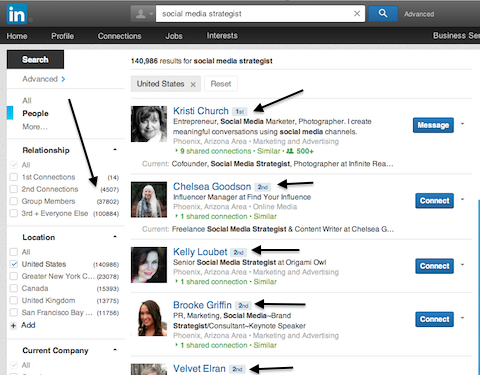
The bottom line of managing LinkedIn is that you only need to show the 500+ mark next to your profile and you would be considered a part of the elite expert tier. People who see your profile will know you use LinkedIn to do business, add value and connections. Here are some ways to start increasing your Linkedin network.
1. Post Status Updates Daily
It’s vital to be active on LinkedIn by starting to post status updates everyday. Think of your LinkedIn updates the same way as any social media posting. Make sure they add value, talk about your business, and include a call to action.
When you consistently stay in the feeds of your connections, there are more opportunities for them to comment, like, and share your posts. The interactions would introduce you to their connections and bring you to grow your network. When people are sharing and commenting on your stuff, it’s social proof that you’re an expert in your field.
2. Engage with Your Connections’ Updates
Review your LinkedIn page regularly, share, comment on, and like other people’s updates and long-formed posts.
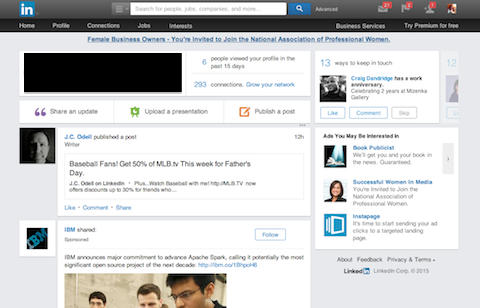
Start relationships with new connections by commenting on their updates. Catch eye audiences by joining conversations on popular posts in your niche. This interaction lets people know you exist and gives you more visibility and activities. Some of these people might want to know more about you, which can lead to new connections.
3. Personalize Connection Requests
Review LinkedIn’s suggested connections at least a few times a week. Try to find people in your industry or niche and personally connect with them. Try to connect with two or three people each time.
When you send a connection request, personalize it in some way for that person. How did you meet? How do you know him or her? Why do you want to connect? Here’s an example of a simple but personal connection request you can tweak and reuse.
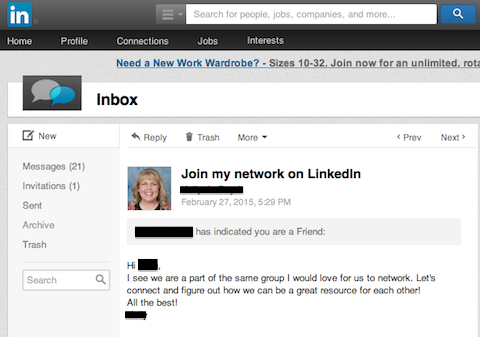
Personalized connection requests increase more chances for you to have people approve your requests and give you better chances to open sale marketing.
4. Add Your LinkedIn URL to Your Email Signature
Your LinkedIn profile will represent you in many ways such as a resume, a testimonial, a social proof, a portfolio of projects/clients, and proof of expert value. They are all in one convenient place. Including in your email signature, Linkedin URL can help you land on more recognition platforms professionally.
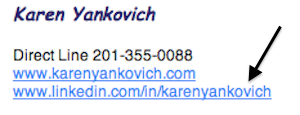
5. Join and Participate in Groups
Be active to search for new LinkedIn groups to join each month. Then, make sure you engage with each group often by commenting, asking questions, and liking other people’s comments ideally everyday.
Being in a group is a great opportunity to do market research, to post links to your updates, to get more views, and to engage with others in your niche, as well as those who aren’t. When people see you in groups and interact with you over time, they’ll be more willing to connect. You might even find potential clients or business partners through a group.
To find groups to join, enter relevant keywords into the LinkedIn search box. Once you find and join a group, participate by starting a discussion or asking a question. Be sure to join both big and small groups. Also, consider creating your own group. This brings you instant credibility because people like to network with experts and other well-connected people. When people join your group, they’ll likely want to connect with you, who is the group owner. They already know who you are and like what you have to say and present.
6. Add Keywords to Your Profile
To make it easy for people to find you by adding keywords to your LinkedIn profile. The three main areas to focus on are your headline, summary, and experience sections. All of these sections are searchable. Adding keywords will lead to more views, make you more searchable, and increase the potential for new connections.
When creating these sections, be creative to tell stories, use every character allowed, and work in relevant keywords that people will search for. For example, if you run your own business, you might be called president or CEO. Let 's think about how many people will actually search for those terms? Instead, use keywords that describe what you do as in the headline below.
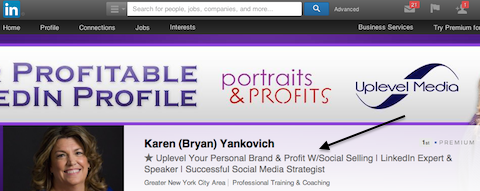
7. Leverage Local Networking Groups
If you belong to a local networking group, look through your membership directory and send LinkedIn connection requests to individual members. Even if you don’t remember meeting someone in person, use your shared real-world connection to personalize your connection request and start to get to know that person online.
For example, you could say something like “We’re both members of (local group name), and I would love to connect with you.” Then head to your next networking meeting newly armed with great networking info. Search for local group members in LinkedIn groups. You may find them there as well.
8. Post Content to LinkedIn’s Publishing Platform
LinkedIn has a publishing platform that makes it easy to publish attractive posts, look like an expert in a professional format.
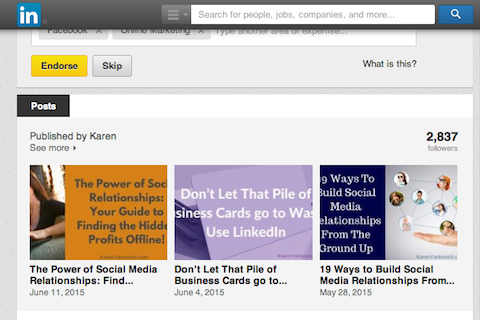
One of the main benefits of publishing platform is that your posts are seen by the entire LinkedIn community, not just your connections, which increases your exposure. Getting recognized by a wild ranged audience will help you build your network by reaching the fourth layer and more. Make sure you publish at least a few times a month to keep your content fresh and decent. If you have no ideas what to publish, consider repurposing your blog posts or newsletter content.
Set a goal to try at least one or two of these tips each week. You’ll be able to track your success as your number of connections starts to march toward 501+ and beyond.

The Do’s and Don’ts When Working with Recruiters
In order to work effectively with a recruiter, you need to know how to communicate with them.
Many job hunters discuss networking as being a vital component to a successful job search. While the majority recognizes that the importance of building the right relationships, a few know how to establish a rapport with a key group - Headhunters.
The ability to build ongoing relationships with influential recruiters can be beneficial to your career success than any other networking. In order to influence a headhunter, you must know how to interact with them. Working with recruiters can have a wide variety of benefits.
To assist you, we’ve listed important communication DO’s and Don’ts of working with a recruiter. Understanding the importance of recruiter relationships. Why is it very beneficial to learn how to interact with talent search professionals and work with recruiters effectively? Alliances with the right staffing agents can assist you in several different ways. Competent recruiters can do the following:
- Open up additional job opportunities you didn’t know about.
- Provide key insight into the job market.
- Help negotiate higher compensation packages.
- Provide critical resume and job-search advice to enhance resume.
Since your goal is to have lasting relationships with headhunters, it’s necessary to understand how to work with recruiters effectively and communicate well. Here is what you should be doing:
1. Do clearly convey your career goals.
Often, job seekers complain about being under pressure to interview for jobs that they are not interested in or qualified for. This results them to make a bad impression during the interview which, in turn, hurts their ongoing relationship with that recruiting agent.
However, you can prevent this by clearly conveying your professional goals to the recruiter. When a headhunter knows exactly what you’re looking for, they can more accurately make career suggestions without putting you in an awkward spot. If you are approached for a job you are not interested in, it’s best that you politely decline, thank the recruiter for their consideration and tell them what interests you.
2. Don’t be indecisive.
Don’t interview just to get in the recruiter’s good graces. Doing so will not strengthen the relationship, and will ultimately come back to hurt you. Whether you interview well and don’t accept a job, or don’t receive an offer, it’s a lose-lose situation.
3. Do allow the recruiter to call the shots.
One of the best ways to get on the good side of a recruiter is to simply allow them to do their job. On occasion, job applicants have trouble not being in control of the hiring process. Anxiety forces them to take certain actions which can be perceived as stepping on the toes of the recruiter. For instance, when working with an executive recruiter, it’s in your best interest to ask them permission (as well as their opinion), or keep them in the loop with any client contact. This includes sending thank you notes to interviewers with the individual cc’d, all the way to negotiating salary through the headhunter unless directed otherwise.
The rule of thumb is that if you don’t know the way a staffing professional likes to work, it’s best to ask. Inquiring about their preferences and being compliant with those requests builds trust and fosters long-term relationships.
4. Do remain cordial and professional even if you do not get the job.
Another great way to get into a recruiter’s good graces is to be gracious upon losing an offer. Sometimes, applicants will give bad words to the hiring manager, which makes later them look petty and unprofessional. This is not to mention that they are talking poorly about the recruiters’ clients. How you behave when things don’t go your way is just as important as how you behave when they do.
By appreciating the recruiter for their time and informing them that you’d be interested in anything similar that comes along would leave the door open for you to work again with the individual.
5. Don’t be a sore loser.
Recruiters find that the sour grapes mentality very off-putting and complaining has no benefit to you. Sometimes you get the job, sometimes you don’t. However, never lose your composure when things don’t go your way.
At the end. If played correctly, working with a recruiter will do nothing but benefit your career. Whether or not you end up a taking a job today is not as important as whether or not you’ll be considered in the future.

Access to a physical campus is among the advantages of attending a local community college as an online student.
Making the decision to pursue an online program can be very difficult for students. Online Learning Lessons offers tips and advice from online students and educators on everything from finding a program and paying for it to what happens after enrolling.
Since the beginnings of American community colleges in 1901, these institutions have typically focused on meeting the academic, professional and vocational needs of nontraditional, financially constrained students bound to a certain location. Community colleges have been successful, growing undergraduate enrollment faster than their four-year public, four-year private and for-profit competitors from 2000 to 2015. Findings from the National Center for Education Statistics show that in autumn 2014, of 6.4 million students attending public community colleges, 1.8 million students enrolling in at least one online course, with 690,000 students attending community colleges completely online.
Over time, more online programs and degrees have become available. For example, Wake Technical Community College in Raleigh, North Carolina, offers more than 100 online programs. While community colleges may not have the reputational prestige of large, national online colleges, they generally have a much lower sticker price. Here are three additional advantages of attending an online program at a public community college.

1. Access to campus services
Attending a local community college as an online student allows physical access to a campus. This enables students to study together or collaborate on projects. Furthermore, services and offerings such as the library, health and fitness centers, career services, advising, tutoring and disability services, faculty office hours, and student clubs are more easily accessible. While many online programs have attempted to virtualize many of these services, some are simply more engaging when experienced face to face.
2. Local employer connections
Because the mission of the institution is usually tied to the community's economic and intellectual health, community colleges offer more programs bridged directly to local industry and workforce needs. Many community colleges pride themselves on the number and quality of partnerships they have with local employers. Employers and corporations rely on community colleges to recruit and develop their workforce.
CUNY Bronx Community College in New York, for instance, offers online courses and certificates designed in partnership with experts from high-demand fields such as project management and cybersecurity.
3. Great pathways to four-year colleges
For students seeking to complete a four-year degree, many community colleges have developed pre-established or seamless transfer pathways to local four-year universities. For example, the University of Central Florida offers the DirectConnect to UCF program, which guarantees admission to UCF for students who complete an associate degree at one of six partner colleges. Students can complete a bachelor's degree in a shorter amount of time and have access to UCF's campuses and student services, even as an online student.
The Remarks
Students contemplating online programs have more choices than ever before. Ensure to consider the cost, convenience, accessibility, and opportunities present at regional community colleges. While local programs may not have the same marketing power as their national competitors, they can offer online students an excellent experience.

In spite of shifting energy policy, the clean energy economy remains a big source of jobs estimated at 4 million positions with wind and solar jobs where are outpacing those in coal.
While changes to federal, state, and local incentives and policies have sparked uncertainty, the job market is still set to grow as businesses and the local governments will build demand.
What’s driving clean energy job growth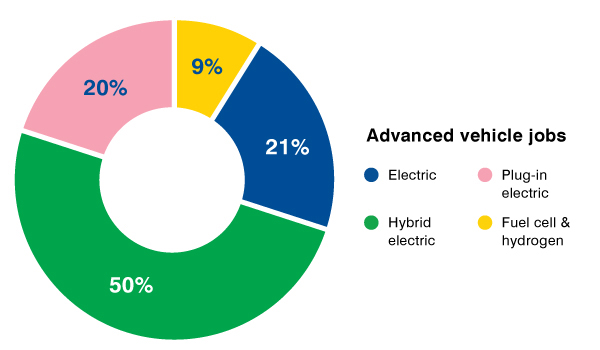
The clean energy workforce has skyrocketed in recent years, and it is consequent from dropping technology costs, having more demand for clean energy and efficiency technology, and offering supportive policies and investments.
The growth of opportunities have been shown by a wide range of well-paying jobs, including installing solar panels, auditing energy efficiency, developing electric vehicles and more.
Most promising clean energy job sectors
In this changing energy economy, we see clean energy jobs in every state, in four main sectors:
1:- Renewable Energy
The renewable energy sector employs 777,000 people, roughly the same as the U.S. telecommunications industry. Bioenergy – which comes from organic material – remains the largest employer, while the solar industry is second.
The most rapid renewable energy job growth has come from the solar and wind sectors, which has arisen by 24.5 percent and 16 percent, respectively, from 2016 to 2017. Solar and wind energy jobs outnumber coal and gas jobs in 30 states, including the District of Columbia. Being declined, the coal industry now employs 160,000 workers, which is less than a quarter as many Americans as the renewable energy industry.
2:- Energy storage and advanced grid
Energy storage systems help ensure that we get the energy we need when we want it, and make it easier to use renewable energy in our homes and on the power grid by balancing out the effects of a cloud moving over a solar panel or the wind dying down.
In 2016, energy storage jobs surged 235 percent from the previous year to reach 90,800 jobs. Meanwhile, efforts to create a more modern power grid have created more than 55,000 jobs.
3:- Energy efficiency
Centerbridge Partners L.P., a private investment firm, hired EDF Climate Corps fellow Astha Ummat to reduce operating expenses by finding ways to conserve energy.
Energy efficiency jobs make up most of the U.S. clean energy workforce – at least 2.2 million workers. They cover a range of work across industries which are mostly construction jobs and installing energy-efficient equipment vendors.
Even in states with major fossil fuel industries, energy efficiency employment completes oil, gas, and coal. Kentucky, for example, has an estimated 24,000 workers in energy efficiency, compared with about 12,200 in coal.
4:- Advanced vehicles and transportation
This sector employs 174,000 Americans who develop and make electric vehicles, including electrical and mechanical engineers and assembly line workers.
U.S. automakers are making commitments to invest more. For example, in early 2018 Ford released plans to invest $11 billion over the next five years and offer 40 different hybrid and fully electric vehicles by 2022.
Policy is uncertain, but gains are holding
In the outlook for some sectors, particularly solar has started to show the effects of an increasingly uncertain policy environment, such as slower growth. But we’re still seeing strong support for the clean energy economy. A wave of investments and commitments from governments, nonprofits and businesses have fueled progress, which boosted local economies and supported millions of jobs.
New technology is gaining momentum as solutions for today’s energy problems, and innovative collaborations between the private and public sectors are demonstrating the demand for a clean energy future. The main idea still points to more well-paying and local jobs to come.

About On Careers
Our team contributors give their best advice on answering common interview questions, perfecting job applications, negotiating salary and more.With Equal Pay Day happening recently, let's take a look at some of the latest outcomes in the gender pay gap. This 2018 research reveals why it's so important for women to take a strategic approach to negotiating their salary.
Disappointing Findings
A new report from employment site-Hired, Inc. called The State of Wage Inequality in the Workplace stated that, unfortunately the pay gap is still aliveand active in the United States. According to the report, nearly two-thirds of the time (63 percent), men are being offered higher salaries than women for performing the same role in the same company. In some organizations, women received pay offers that were dramatically lower than their male same level colleagues. This means that it is up to 45 percent less. These figures essentially match the numbers that Hired announced in last year's survey, showing little-to-no progress in closing the wage gap.
While the Hired study has illuminated mainly on positions in the technology industry, they did some comparative research in order to examine the situation in different sectors. They found that inequities between men's and women's pay persist across diverse industries, including finance and health care. Importantly, the largest pay gap appeared in education technology.

What's else more?
Race is also a major impact on pay disparities, with black and Hispanic women earning 10 % less in each dollar earned by white men. Additionally, Hired found that as women age, the wage gap expands.
PayScale also released a new study on The State of the Gender Pay Gap 2018. The findings were fierce here as well. According to PayScale, today women earn 22.1 % less in every dollar that men earn. For example, in 2018 women's median salary is still around 22 percent lower than men's. Another important point that PayScale's study shown is that by the middle of their career, men become much more likely (possibly 70 percent) to have moved up to an executive role compared with women. This situation worsens over time, with nearly 59 percent of women still working in individual contributor positions by their late career, compared with just 43 percent of men. This discrepancy is often referred to as the “Opportunity Gap of Gender."
Taking Action
What can be done to close the gender pay gap as well as the opportunity gap?
While 42 percent of the survey respondents to the Hired believe that the effort must be collaborative among government, companies, and employees. The research points out something that women specifically can do. "According to the data, in 66 percent of the time, women are asking for less money, which means 6 percent less on average than men in the same role at the same company," said Kelli Dragovich, Senior Vice President at Hired. "We want women to feel empowered to ask for their market worth and we believe salary transparency will get us there." With this in mind, Dragovich offers the following negotiation recommendations for women:
Legislative action and corporate initiatives are both vital keys to overcome the gender pay gap. However, rather than waiting for slow-moving change to catch up with the growing unfairness outcomes in workplace, women can make a difference in their "personal pay gap" by implementing savvy negotiating strategies – while at the same time moving everyone closer to true wage equity.

As an HR in today's competitive business environment, what would be your answer when your employer asks for ideas on how to more strategically manage the talent in organization? Whether you work in a mid-cap company where the right professional level talent to grow multi-nationally is not required. Or a large-cap one who's fixed recruiting cost has pressurized you for optimizing talent supply.
So, you begin wondering whether Recruitment Process Outsourcing is the only potential solution. Yes, it is the best way to get talented people for an organization without hampering business operations. Despite many RPO service providers, IBA Infotech is the most trusted RPO companies in India who can meet your recruitment requirements in an efficient way. Well, definitely RPO has become a major part of every industry in this fast pace of business management. Rather than hiring people on your own, you will be more focused on other essential company operations while outsourcing human resource process. Before going further, you must know about Recruitment Process Outsourcing.
Recruitment process outsourcing or RPO is a form of business process outsourcing or BPO in which an employer transfers every part of human resource process to an external service provider. An RPO service company can provide its own or may assume the company's technologies, staff, reporting and methodologies. For managing your recruitment procedures, you must get perfect RPO companies in USA. So, what kind of benefits recruitment process outsourcing provides? Let's have a look.
In nutshell, recruitment process outsourcing (RPO) companies has become a common resource for companies to find talent across the globe without hampering business activities. It gives a peace of mind to an employer who takes all recruitment procedures itself earlier. So, get a reliable RPO service provider who will make suitable candidates available for your organization.

In today's business environment, operational cost efficiency is an organizational imperative. Many times companies have to reevaluate their cost structure and recruitment process, particularly when there is a recession. Now what to do for deducting human resource cost? Is RPO is the only solution for reducing cost of a company? The answer of these questions is recruitment process outsourcing, which ease out the work pressure when it comes to hire people for various positions in different industries.
So, it is essential for any kind of businesses to outsource recruitment process in order to save time and money and put them in other important business tasks. To get the best and experienced RPO provider, you can go for IBA Infotech, which is one of the top RPO companies in India and help you to indentify right person for right job.
3 Ways RPO Reduces Company Cost:
Having RPO services is the best way to reduce the cost of company as every piece of work related to human resource is given to outsider. It helps in achieving organizational objectives as main focus is put on key business operations. So, find a suitable recruitment process outsourcing service provider and get the talented employees for your organization.

Job Seekers...!!! If you have previously applied and need to reapply Click HERE
Are you...
If you answer "yes" to one or more of those questions, you may be eligible to participate in Ready to Work with our clients.
We Can Help You Find Full-Time/Contract Jobs Ready to Work with our clients, We Provides Coaching, Training, and Job Placement Services for the Long-Term Unemployed, Fresher or just College passout , or Underemployed.!!!
This program provide you coaching and on-job skills training, leading to a permanent, full-time job with a participating employer. You will be prepared while in training for interview skills. It is anticipated that successful job candidates will get middle level jobs or begin a new one with a career pathway. This program also trains incumbent employees for promotions or new work with their current employer, creating new openings for the unemployed.
Eligibility Criteria for the Long-Term Unemployed
Preference will be given to equally to all.
Why Should I Register for this Program?
If you wish to be considered for this program, you must complete our online registration form. By completing the form, you will give us the precise information we need to determine if you qualify. The information you provide also will help us determine if you are a good fit for a job that is already open with our clients.
If I Do Qualify, What Happens Next?
If you qualify and are accepted as a program candidate, you will be interviewed by a Ready to Work career counselor, who will ask you questions on a variety of topics. The counselor will assess your experiences, skills and qualifications. (Some candidates also will be assessed for their employability or soft skills.). Based on this information, we will develop an Individual Employability Plan to move you through the coaching, training and re-employment process. The main goal of the program is to give you on-the-job training with a participating employer, leading to permanent, full-time/contract employment - and to do this as quickly as possible. Outside training will be provided by one of our education partners, which include four year colleges/universities and the state's 19 community colleges.
How it is Beneficial ?
Jobs Type :
Full time :- With desired salary and benefits.
Contract :- With best hourly rates with possible extension.
Contract to Hire :- With hourly rate till contract periods and salary after clients hires you for same project.
Enrolled into this programm has following benefits:-
More than 15 jobs apply on potential client requirement per day. Our experts predicts urgent requirement form all job boards and team apply on behalf of candidates.